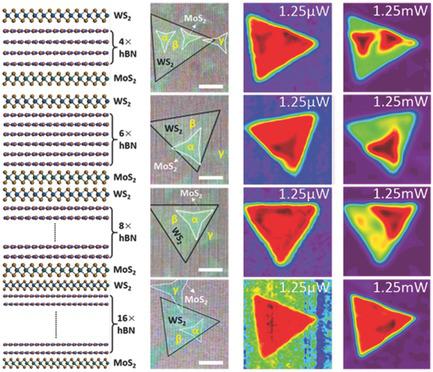Our official English website, www.x-mol.net, welcomes your
feedback! (Note: you will need to create a separate account there.)
Determining the Optimized Interlayer Separation Distance in Vertical Stacked 2D WS2:hBN:MoS2 Heterostructures for Exciton Energy Transfer
Small ( IF 13.0 ) Pub Date : 2018-02-07 , DOI: 10.1002/smll.201703727 Wenshuo Xu 1 , Daichi Kozawa 2 , Yu Liu 3 , Yuewen Sheng 1 , Ke Wei 3 , Volodymyr B. Koman 2 , Shanshan Wang 1 , Xiaochen Wang 1 , Tian Jiang 3 , Michael S. Strano 2 , Jamie H. Warner 1
Small ( IF 13.0 ) Pub Date : 2018-02-07 , DOI: 10.1002/smll.201703727 Wenshuo Xu 1 , Daichi Kozawa 2 , Yu Liu 3 , Yuewen Sheng 1 , Ke Wei 3 , Volodymyr B. Koman 2 , Shanshan Wang 1 , Xiaochen Wang 1 , Tian Jiang 3 , Michael S. Strano 2 , Jamie H. Warner 1
Affiliation

|
The 2D semiconductor monolayer transition metal dichalcogenides, WS2 and MoS2, are grown by chemical vapor deposition (CVD) and assembled by sequential transfer into vertical layered heterostructures (VLHs). Insulating hBN, also produced by CVD, is utilized to control the separation between WS2 and MoS2 by adjusting the layer number, leading to fine‐scale tuning of the interlayer interactions within the VLHs. The interlayer interactions are studied by photoluminescence (PL) spectroscopy and are demonstrated to be highly sensitive to the input excitation power. For thin hBN separators (one to two layers), the total PL emission switches from quenching to enhancement by increasing the laser power. Femtosecond broadband transient absorption measurements demonstrate that the increase in PL quantum yield results from Förster energy transfer from MoS2 to WS2. The PL signal is further enhanced at cryogenic temperatures due to the suppressed nonradiative decay channels. It is shown that (4 ± 1) layers of hBN are optimum for obtaining PL enhancement in the VLHs. Increasing thickness beyond this causes the enhancement factor to diminish, with the WS2 and MoS2 then behaving as isolated noninteracting monolayers. These results indicate how controlling the exciton generation rate influences energy transfer and plays an important role in the properties of VLHs.
中文翻译:

确定用于激子能量转移的垂直堆叠二维WS2:hBN:MoS2异质结构的最佳层间分隔距离
2D半导体单层过渡金属二硫化钨WS 2和MoS 2通过化学气相沉积(CVD)生长,并通过顺序转移到垂直分层异质结构(VLHs)中进行组装。同样通过CVD产生的绝缘hBN用于控制WS 2和MoS 2之间的分离通过调整层数,可以对VLH中的层间相互作用进行精细调整。通过光致发光(PL)光谱研究了层间相互作用,并证明对输入激发功率高度敏感。对于薄的hBN分离器(一到两层),总的PL发射通过增加激光功率从淬灭变为增强。飞秒宽带瞬态吸收测量结果表明,PL量子产率的提高是由于Förster能量从MoS 2转移到WS 2引起的。由于抑制了非辐射衰变通道,因此在低温下PL信号得到了进一步增强。结果表明,hBN的(4±1)层对于在VLHs中获得PL增强是最佳的。超过此厚度会导致增强因子减小,然后WS 2和MoS 2表现为孤立的非相互作用单层。这些结果表明,控制激子产生速率如何影响能量传递,并在VLHs的性质中起重要作用。
更新日期:2018-02-07
中文翻译:

确定用于激子能量转移的垂直堆叠二维WS2:hBN:MoS2异质结构的最佳层间分隔距离
2D半导体单层过渡金属二硫化钨WS 2和MoS 2通过化学气相沉积(CVD)生长,并通过顺序转移到垂直分层异质结构(VLHs)中进行组装。同样通过CVD产生的绝缘hBN用于控制WS 2和MoS 2之间的分离通过调整层数,可以对VLH中的层间相互作用进行精细调整。通过光致发光(PL)光谱研究了层间相互作用,并证明对输入激发功率高度敏感。对于薄的hBN分离器(一到两层),总的PL发射通过增加激光功率从淬灭变为增强。飞秒宽带瞬态吸收测量结果表明,PL量子产率的提高是由于Förster能量从MoS 2转移到WS 2引起的。由于抑制了非辐射衰变通道,因此在低温下PL信号得到了进一步增强。结果表明,hBN的(4±1)层对于在VLHs中获得PL增强是最佳的。超过此厚度会导致增强因子减小,然后WS 2和MoS 2表现为孤立的非相互作用单层。这些结果表明,控制激子产生速率如何影响能量传递,并在VLHs的性质中起重要作用。











































 京公网安备 11010802027423号
京公网安备 11010802027423号